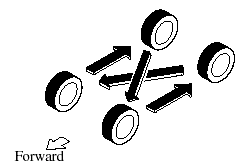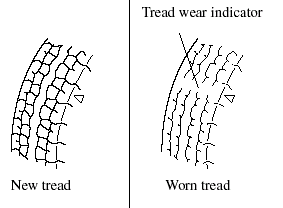Tire Maintenance
Improper or inadequate vehicle maintenance can cause tires to wear
abnormally. Here are
some important maintenance points:
Tire Inflation Pressure
Inspect all tire pressure monthly (including the spare) when the tires are
cold. Maintain
recommended pressures for the best ride, top handling, and minimum tire wear.
Use the
pressures specified on the vehicle tire information placard or tire label for
optimum service.
Tire Rotation
To equalize tread wear, rotate the tires every 12,000 km (7,500 miles) or
sooner if irregular
wear develops. During rotation, inspect them for correct balance.

Do not include (TEMPORARY USE ONLY) spare tire in rotation.
Inspect the tires for uneven wear and damage. Abnormal wear is usually caused
by one or a
combination of the following:
- Incorrect tire pressure.
- Improper wheel alignment.
- Out-of-balance wheel.
- Severe braking.
After rotation, inflate all tire pressures to specification and
inspect the lug nuts
for tightness.
CAUTION:
Rotate unidirectional tires and radial tires that have an asymmetrical tread
pattern
or studs only from front to rear, not from side to side. Tire performance will
be
weakened if rotated from side to side.
Replacing a Tire
WARNING:
Always use tires that are in good condition:
Driving with worn tires is dangerous. Reduced braking, steering, and traction
could
result in an accident.
If a tire wears evenly, a wear indicator will appear as a solid band across
the tread. Replace
the tire when this happens.

You should replace it before the band is across the entire tread.
NOTE:
Tires degrade over time, even when they are not being used on the road. It is
recommended that tires
generally be replaced when they are 6 years or older. Heat caused by hot
climates or frequent high
loading conditions can accelerate the aging process. You should replace the
spare tire when you
replace the other road tires due to the aging of the spare tire. Regarding the
manufacturing week and
year is indicated with 4 digit. Refer to The tire labeling.
Safety Practices
The way you drive has a great deal to do with your tire mileage and safety.
So cultivate
good driving habits for your own benefit.
- Observe posted speed limits.
- Avoid fast starts, stops and turns.
- Avoid potholes and objects on the road.
- Do no run over curbs or hit the tire against the curb when parking.
CAUTION:
If you feel a sudden vibration or ride disturbance while driving or you suspect
your
tire or vehicle has been damaged, immediately reduce your speed. Drive with
caution
until you can safely pull off the road. Stop and inspect the tire for damage. If
the tire
is under-inflated or damaged, deflate it, remove the tire and rim and replace it
with
your spare tire. If you cannot detect a cause, have the vehicle towed to the
nearest
vehicle or tire dealer to have the vehicle inspected.
See also:
Safety Certification
This CD player is made and tested to meet exacting safety standards. It meets
FCC
requirements and complies with safety performance standards of the U.S.
Department of
Health and Human Services. ...
Power Steering Fluid
Inspecting Power Steering Fluid Level
CAUTION.
To avoid damage to the power
steering pump, don't operate the
vehicle for long periods when the
power steering fluid level is low.
NOTE.
Use speci ...
Exterior
The 2010 Mazda3's exterior styling builds on its predecessor's athletic
proportions by emphasizing design features. One of them is the front grille, but
Mazda may have gone a bit too far with it, ...


